Study of Melting Methods by Electric Resistance Welding of Rails
Abstract
1. Introduction
- -
- construction of temperature fields of the weld seam for three welding modes of rail joints;
- -
- investigation of the structure of welded joints after continuous flash welding, pulsating flash welding and combined flash welding;
- -
- investigation of the mechanical properties of welded joints after continuous flash welding, pulsating flash welding and combined flash welding.
2. Methods and Materials
2.1. Chemical Composition of the Studied Materials
2.2. Welding Equipment and Welding Modes of Rail Joints
2.3. Analysis of the Sample Microstructure
2.4. Mechanical Testing of the Samples
2.5. Plotting Cooling Curves of the Samples
3. Factors Affecting Electric Resistance Welding in the Metal Plastic State
3.1. Structure and Properties of the Welded Seam of Rails Obtained under Standard Conditions
- The 0.5–1 mm wide seam is characterized by a light decarbonized bend and the transverse rotation of fibers;
- In the zone of incomplete melting of 1–1.5 mm wide metal, low-melting accumulations and looseness are possible;
- The zone of the finely dispersed eutectoid mixture of pearlite and cementite after overheating, 10–15 mm in thickness, is formed as a result of overheating and recrystallization (formation and growth of grains due to initial deformed grains);
- The zone of the fine eutectoid mixture of pearlite and cementite without overheating, 10–15 mm in thickness, appears after recrystallization of the metal (formation of new crystals from crystals of the previous modification during cooling–from an austenite structure to a pearlite one);
- High 5–10 mm wide tempering zone with transition to base metal;
- Base metal: for heat-strengthened rails–fine pearlite (troosto-sorbite or quenching sorbite), for non-heat-strengthened rails–lamellar pearlite.
3.2. Metallographic Studies of the Rail Weld Obtained by Various Methods of Flash Welding
3.3. Mechanical Properties of the Rail Weld Obtained by Various Methods of Flash Welding
- −
- RWP–1 Oktyabrskaya Railway Station, total number of tested samples–66 pcs. (weld stretching zone–36 pcs., head–30 pcs.);
- −
- RWP–3 Moscow Railway, total number of tested samples–20 pcs. (weld stretching zone–12 pcs., head–8 pcs.);
- −
- RWP–13 Yuzhno-Uralskaya Railway, total number of tested samples–26 pcs. (weld stretching zone–15 pcs., head–11 pcs.);
- −
- RWP–8 Northern railway station, total number of tested samples–30 pcs. (weld stretching zone–15 pcs., head–15 pcs.);
- −
- RWP–19 Far Eastern Railway, total number of tested samples–22 pcs. (weld stretching zone–10 pcs., head–12 pcs.);
- −
- RWP–29 West Siberian Railway, total number of tested samples–60 pcs. (weld stretching zone flange–32 pcs., head–28 pcs.);
- −
- RWP–32 East Siberian Railway, total number of tested samples–26 pcs. (weld stretching zone–13 pcs., head–13 pcs.).
4. Conclusions
- The conducted studies have shown that the flash welding mode significantly affects both the value of the cooling rate and the very nature of the thermal cycle of the welded joint as a whole. The highest cooling rate is reached when welding in the pulsating mode. The cooling rate and cooling curves for continuous and combined modes are almost identical. Changes in the cooling rate under different modes have a primary influence on the structure and properties of the weld seam;
- The results of studying the rail top during local heat treatment of welded joints confirmed the need for intensification of quenching cooling in the central zone of the rail seam. In this zone, the maximum decrease in the hardness of the weld seam occurs owing to the formation of coarse-grained lamellar pearlite with a ferritic network around the former austenitic grains. In turn, a decrease in hardness in the central zone occurs due to its decarbonization;
- Welding rails of the E76HGF steel grade by the contact method by pulsating flash welding can lead to the appearance of needle martensite areas, resulting in embrittlement of the weld seam and a decrease in its properties. As a result of conducting field experiments, it was reliably shown that in the conditions of the combined welding mode it becomes possible to avoid the mentioned problems;
- The use of the combined welding mode of rail joints provides a slight increase in the mechanical properties of the weld seam in the range of 2–4%. Along with this, such slight changes in the properties exert a very significant impact on the operational characteristics. The destructive load of the welded joint of the rail at high values of bending deflection increases by a value within 2–3%. Since in real conditions of rail operation, the load on the joint very rarely exceeds the maximum values, even such slight increase in the mechanical properties can significantly reduce the number of cases of welded rail joint failures.
Author Contributions
Funding
Data Availability Statement
Conflicts of Interest
References
- Pryakhin, E.I.; Sharapova, D.M. Understanding the structure and properties of the heat affected zone in welds and model specimens of high-strength low-alloy steels after simulated heat cycles. CIS Iron Steel Rev. 2020, 19, 60–65. [Google Scholar] [CrossRef]
- Raenok, D.L. Organization and modernization of work in the rail welding production of Russian Railways. Ind. Transp. XXI Century 2011, 5, 52–56. [Google Scholar]
- Zolotarsky, A.F. Thermally Hardened Rails; Transport: Moscow, Russia, 1976. [Google Scholar]
- Aksenov, A.V.; Bugrov, A.V.; Rezanov, A.V. Improving the structural strength of rail welds. In Proceedings of the Science, Innovations and Education: Actual Problems of Development of the Transport Complex of Russia: Materials of the International Scientific and Technical Conference, Ekaterinburg, Russia, 16–17 November 2006; pp. 77–78. [Google Scholar]
- Volchenko, V.N.; Yampolsky, V.M.; Vinokurov, V.A. Theory of Welding Processes; Higher School: Moscow, Russia, 1988. [Google Scholar]
- Nikulina, A.A.; Skeeba VYu Kornienko, E.E.; Mironov, E.N. Simulation of structure formation during welding of heterogeneous steels. Obrab. Met. -Met. Work. Mater. Sci. 2011, 4, 54–61. [Google Scholar]
- Nikulina, A.A.; Skeeba VYu Chevakinskaya, A.; Komarov, P.N. Simulation of Structure Formation Processes of Dissimilar Steels Welded Joints Using an Intermediate Layer. Appl. Mech. Mater. 2015, 788, 218–224. [Google Scholar] [CrossRef]
- Gudkov, A.V.; Turbina, L.A.; Genkin, I.Z. Resistance welding of crosses and rail ends from high-manganese and carbon steels. In Collection of Articles “Resource-Saving Technologies for the Restoration of Railway Equipment”; Intext: Moscow, Russia, 1998. [Google Scholar]
- Gudkov, A.V. Welding and Surfacing Technologies in Railway Transport; Intext: Moscow, Russia, 2008. [Google Scholar]
- Kuchuk-Yatsenko, S.I.; Sakharnov, V.A.; Galyam, B.A. Equipment for Contact Welding of Rails and Its Operation; Naukova Dumka: Kyiv, Russia, 1974. [Google Scholar]
- Falkevich, A.S. Welding of Main and Factory Pipelines; Gostoptenizdat: Moscow, Russia, 1958. [Google Scholar]
- Shur, E.A.; Rezanov, V.A. Improvement of contact welding of rails. Railw. Transp. 2013, 4, 58–60. [Google Scholar]
- Puiko, A.V.; Zuborev, A.V.; Blinkov, I.P. Investigation of the heterogeneity of welded joints made by flash butt welding. Quest. Weld. Prod. 1983, 84–87. [Google Scholar]
- Genkin, I.Z.; Lebedev, A.M.; Khryashchev, N.K.; Shlyapin, V.B. Welding rails in stationary and field conditions. Way Track Facil. 1970, 2, 40–42. [Google Scholar]
- Genkin, I.Z. Improving the operational stability of welded rails. In Some Problems of Mechanization of Work and Reliability of Subway Devices; Transport: Moscow, Russia, 1979; pp. 94–103. [Google Scholar]
- Trens, K.M.; Kozyrev, E.V.; Bazarov, I.S. Welding technology and heat treatment of rails by Mitsui and Co., Ltd. In Meeting Materials; VNIIZhT Ministry of Railways of Russia: Moscow, Russia, 2012. [Google Scholar]
- Nikolin, A.I. Improving the Processes of Welding and Heat Treatment of Rails of Mainline Railways. Ph.D. Dissertation, VNIIZhT Ministry of Railways of Russia, Moscow, Russia, 2004. [Google Scholar]
- Balanovskiy, A.E.; Shtaiger, M.G.; Kondratyev, V.V.; Karlina, A.I. Determination of rail steel structural elements via the method of atomic force microscopy. CIS Iron Steel Rev. 2022, 23, 86–91. [Google Scholar] [CrossRef]
- Balanovsky, A.E.; Shtayger, M.G.; Kondratyev, V.V.; Karlina, A.I.; Govorkov, A.S. Comparative analysis of structural state of welded joints rails using method of Barkhausen effect and ultrasound. J. Phys. Conf. Ser. 2018, 1118, 012006. [Google Scholar] [CrossRef]
- Kuchuk-Yatsenko, S.I.; Didkovsky, A.V. RU 2222415, IPC B 23 K 11/04. Flash Welding Method. Applied 04/13/99. Published 01/27/04. Available online: https://rusneb.ru/catalog/000224_000128_0002222415_20040127_C2_RU/ (accessed on 1 November 2022).
- Lebedev, V.K.; Pismensky, A.A. Power systems for resistance welding machines. Autom. Weld. 2001, 11, 32–36. [Google Scholar]
- Baake, E.; Shpenst, V.A. Recent scientific research on electrothermal metallurgical processes. J. Min. Inst. 2019, 240, 660. [Google Scholar] [CrossRef]
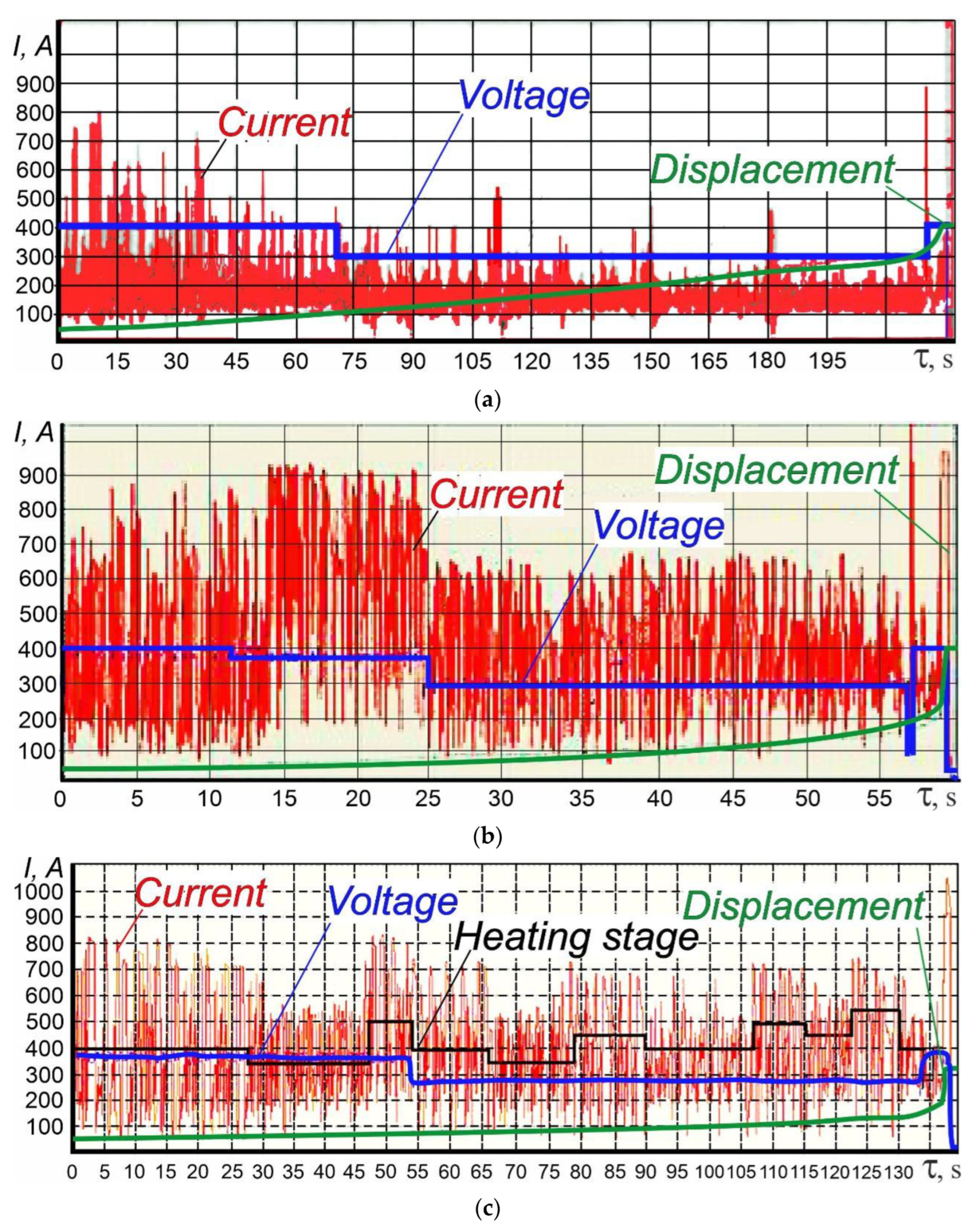
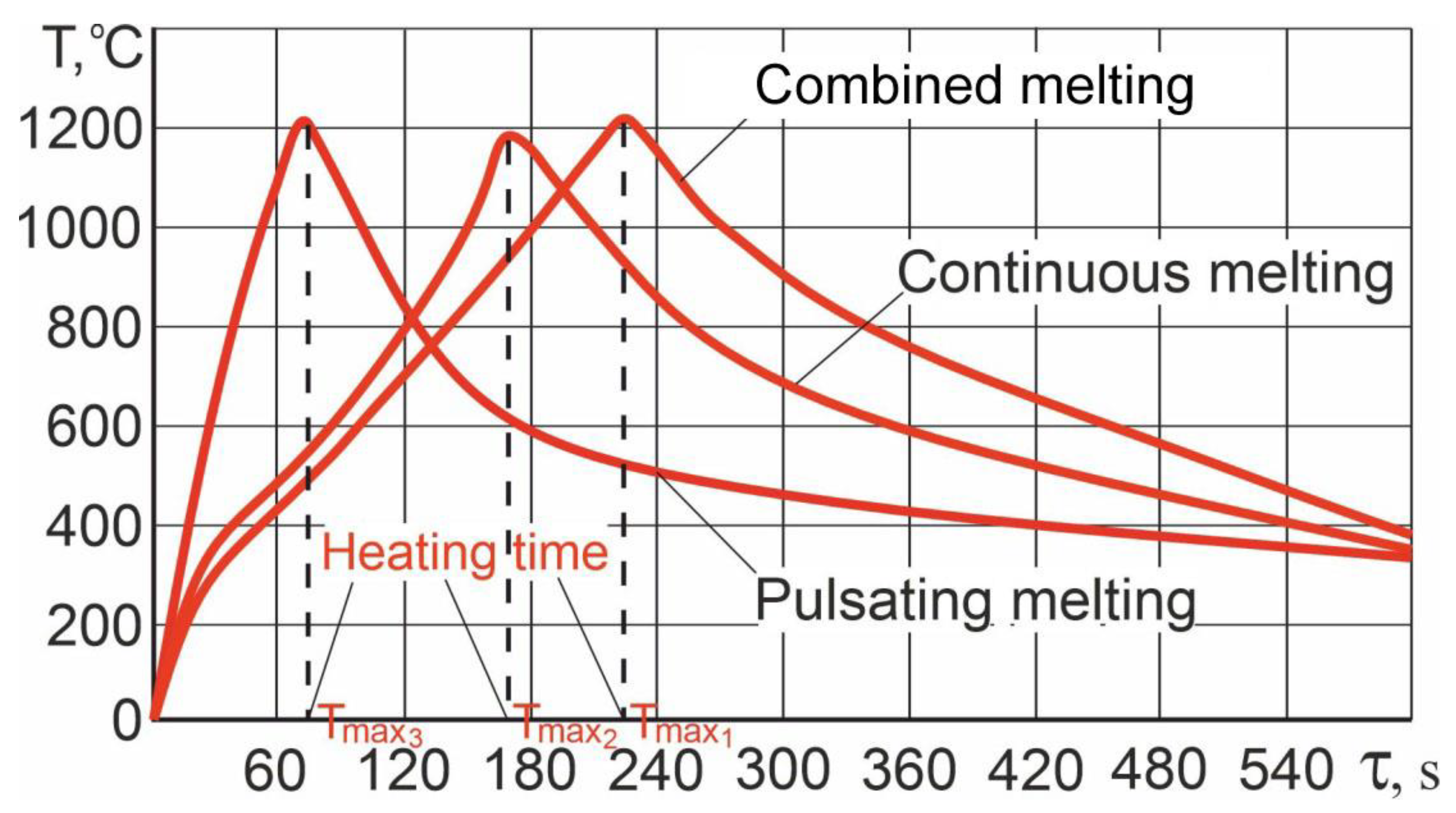
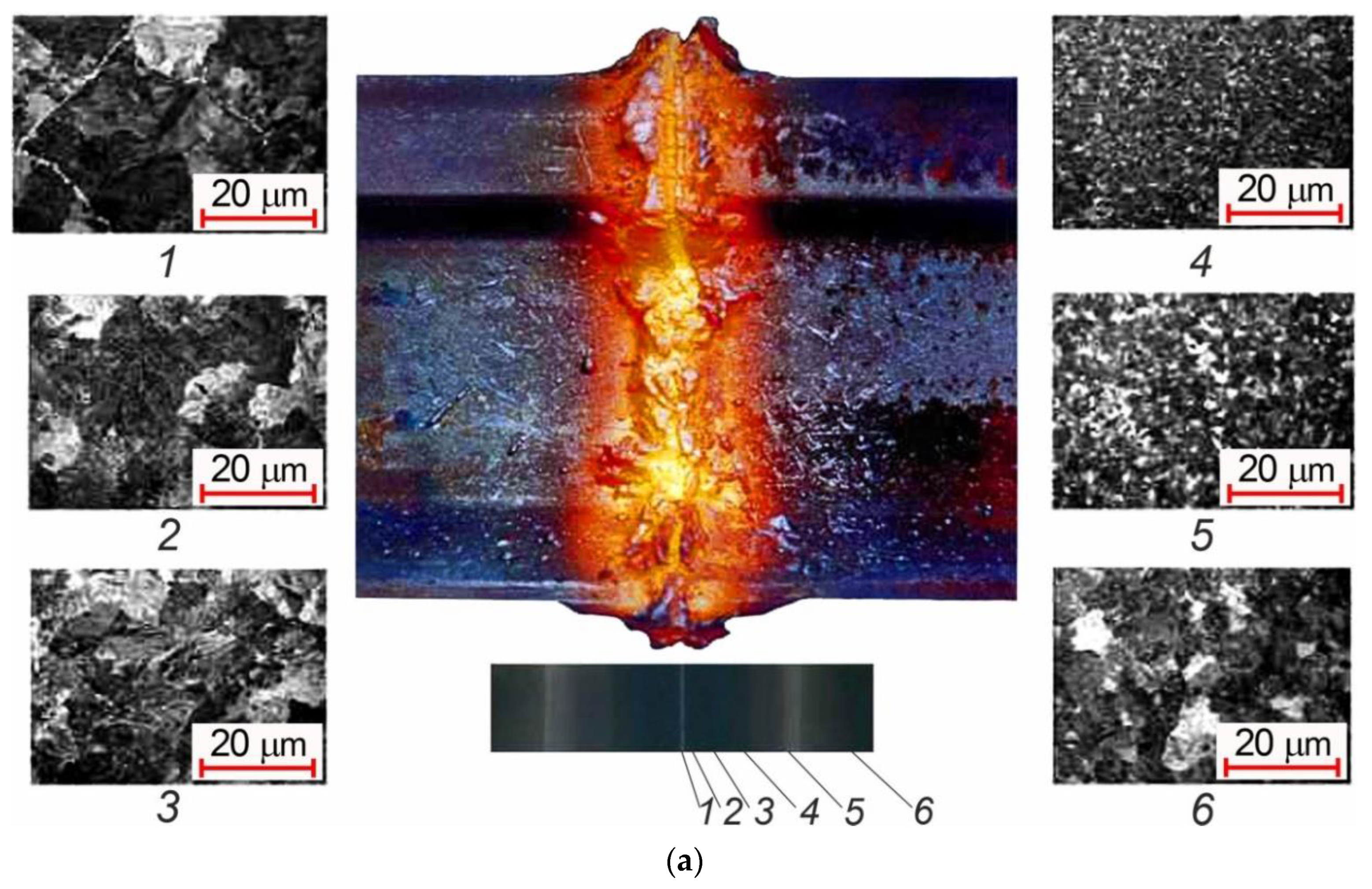

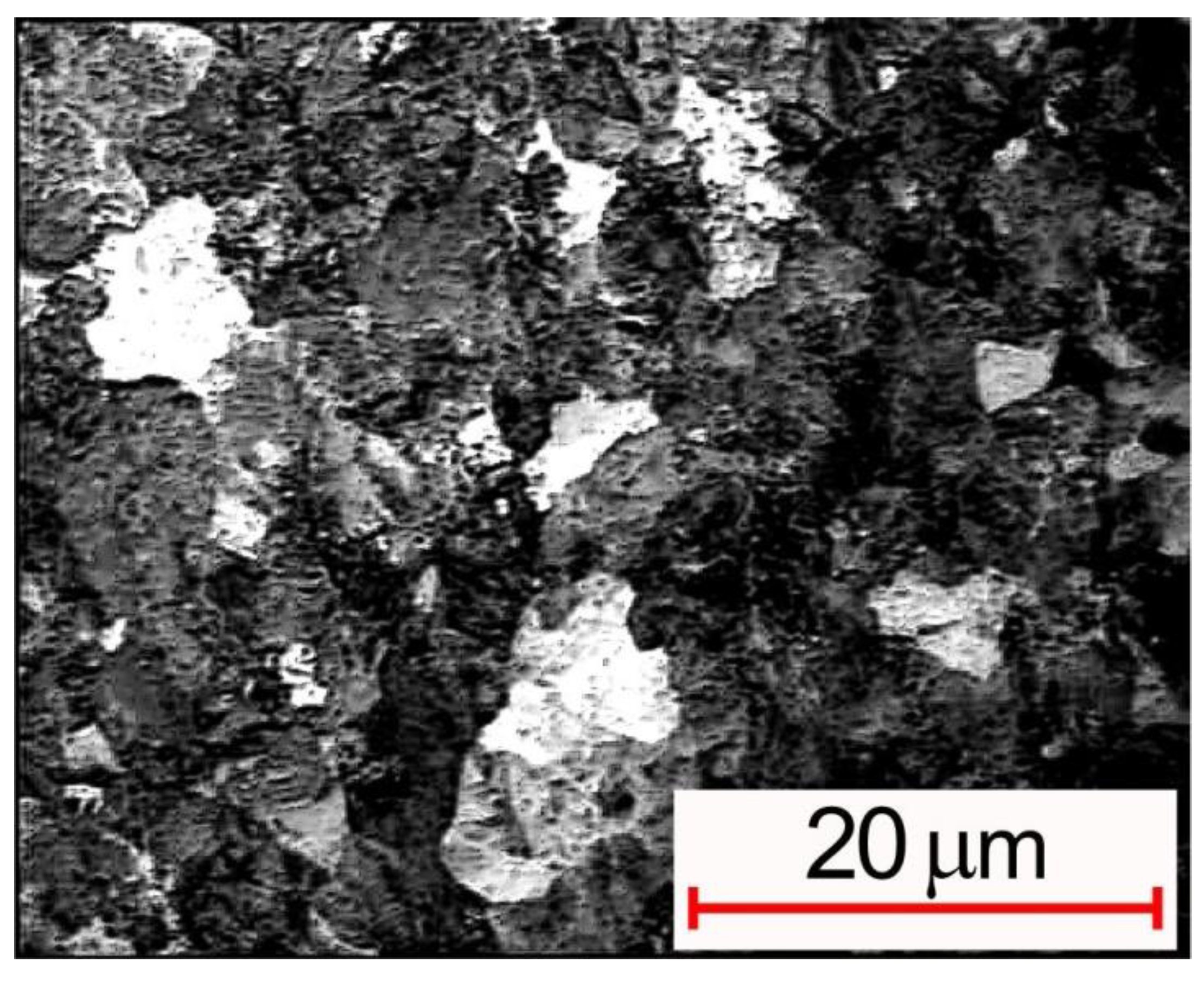

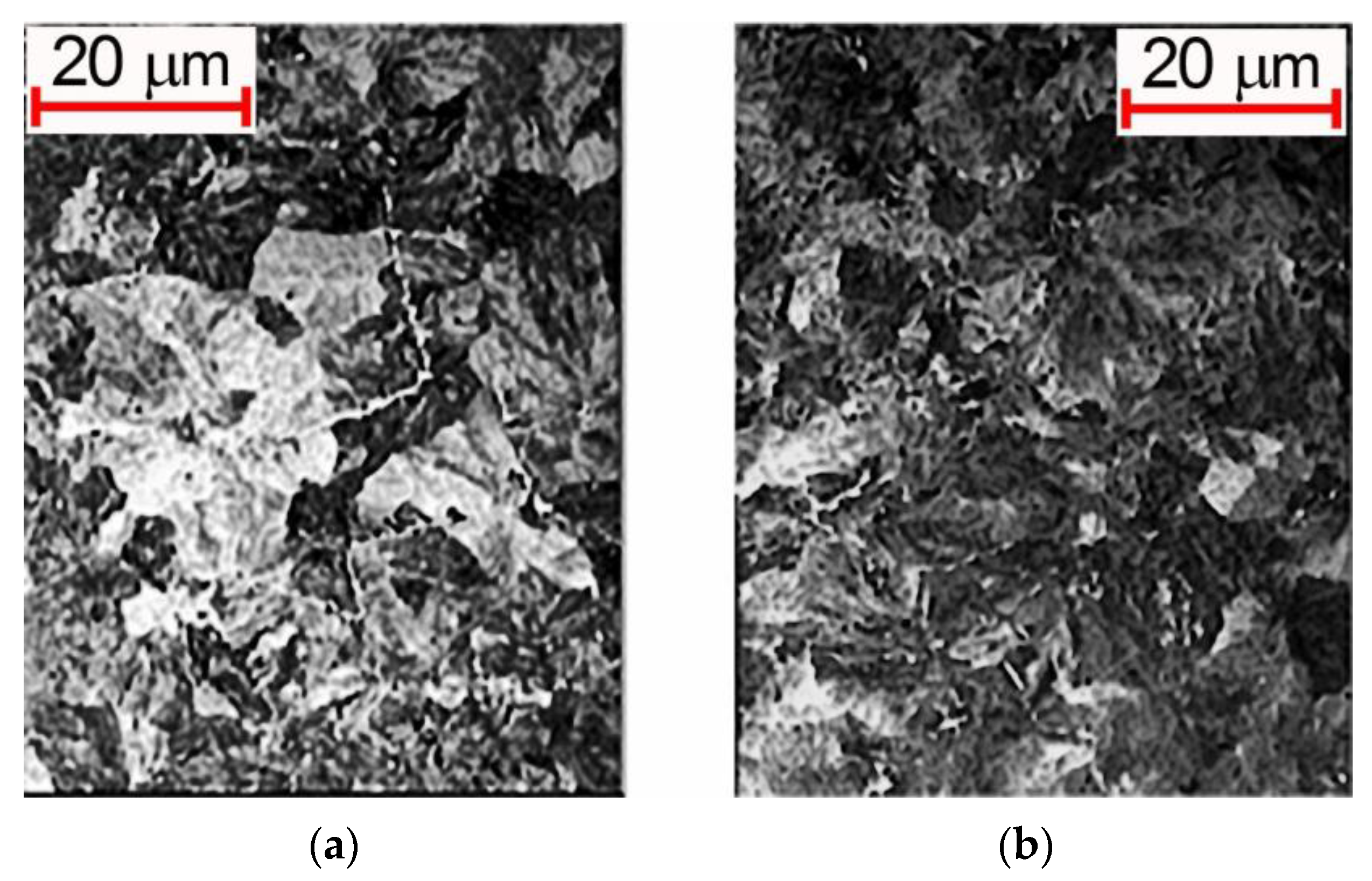
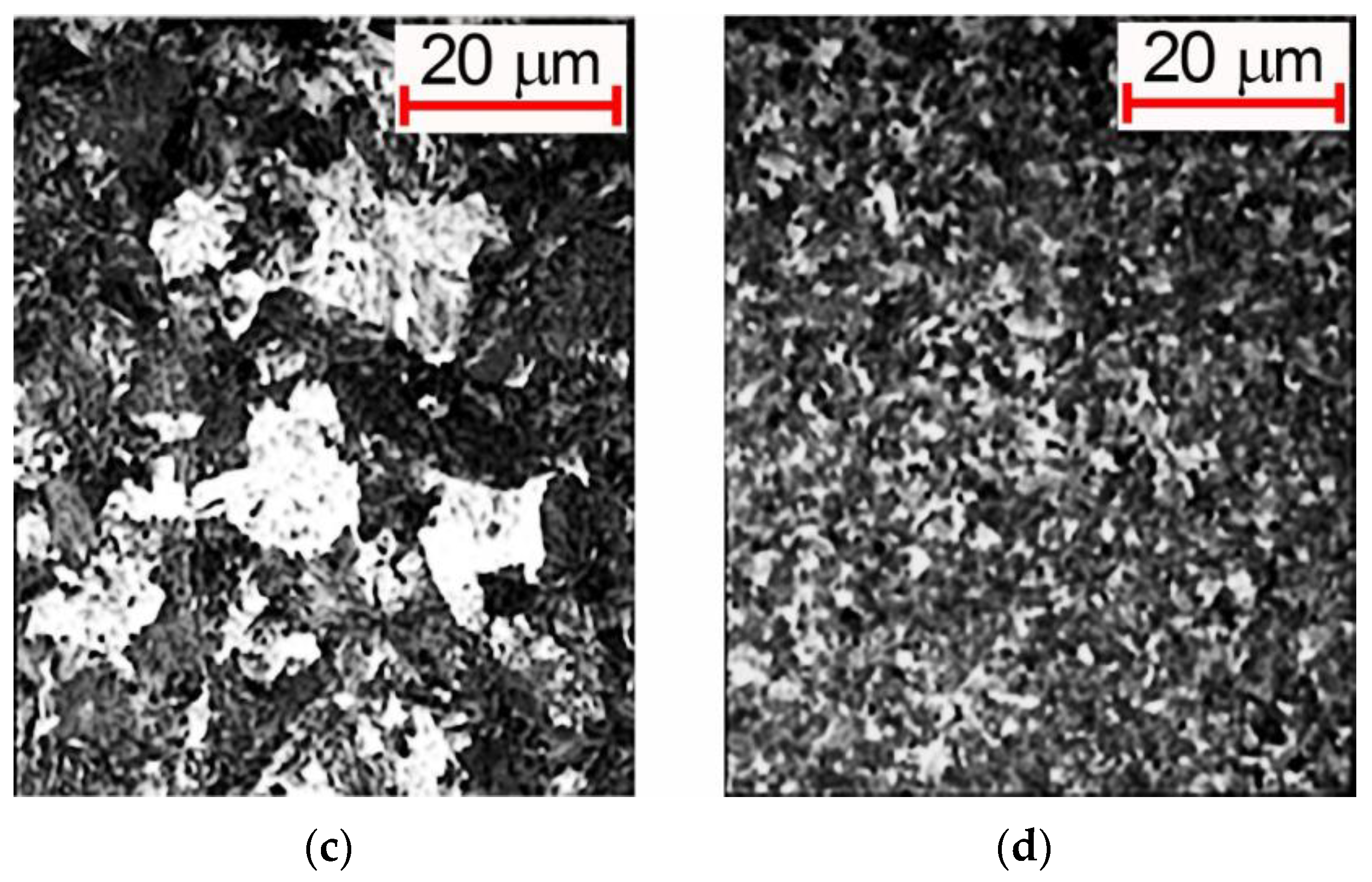
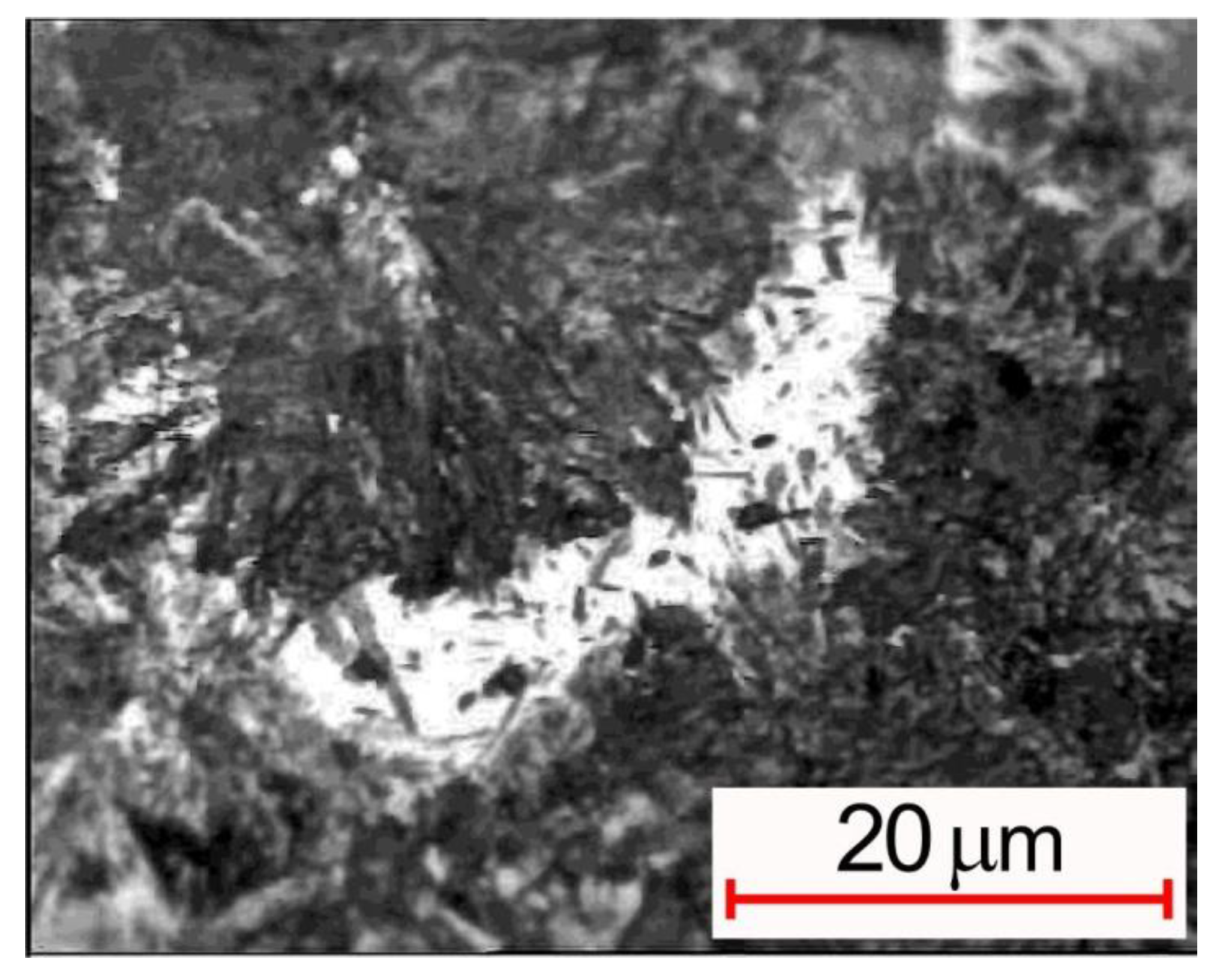
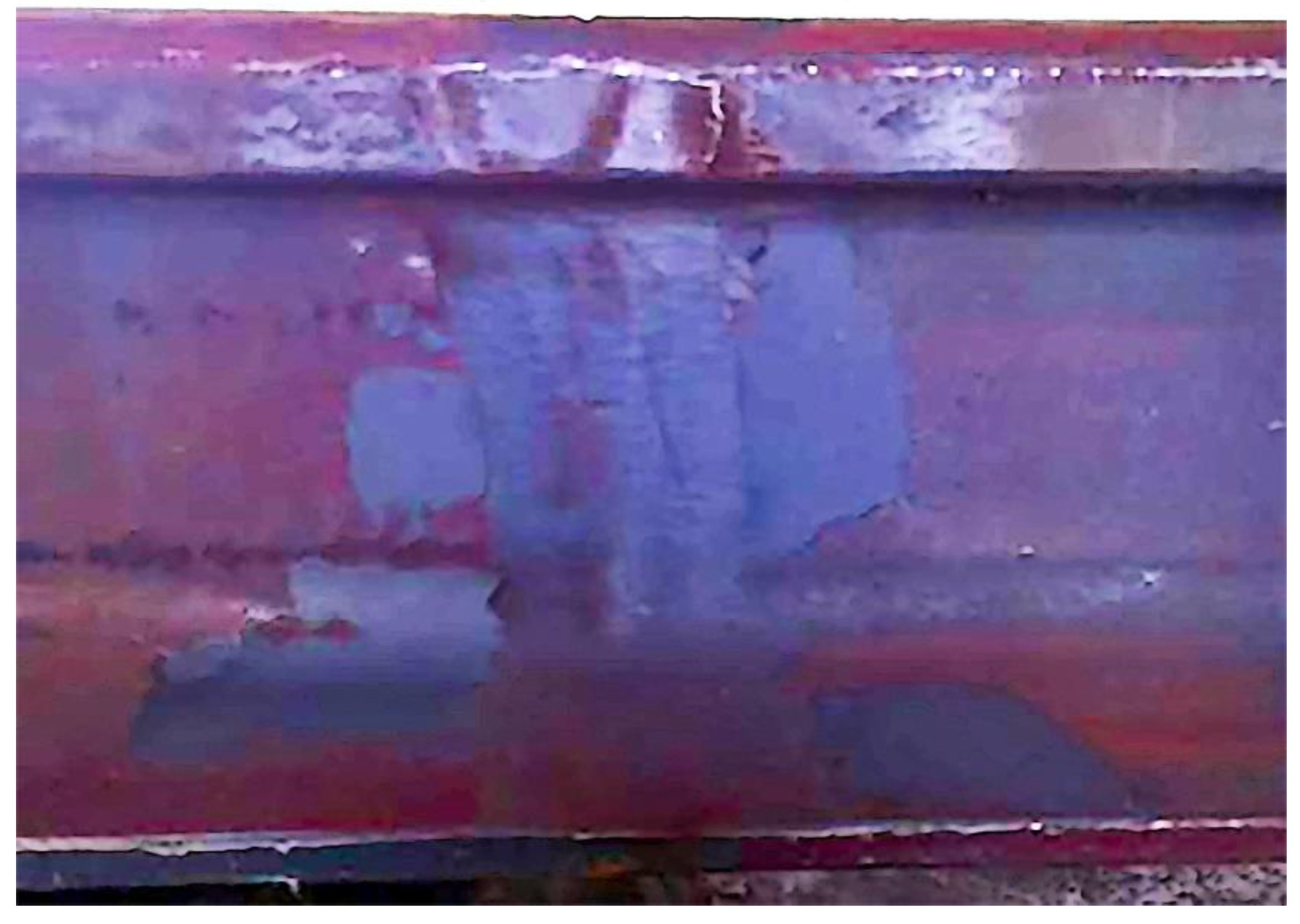

| Steel Grade | Content, % | |||||||
|---|---|---|---|---|---|---|---|---|
| P | S | Al | ||||||
| C | Mn | Si | V | Cr | Not More Than | |||
| E76HGF | 0.73 | 0.83 | 0.37 | 0.06 | 0.75 | 0.017 | 0.007 | 0.0003 |
| E78HSF | 0.69 0.83 | 0.70 1.10 | 0.28 0.62 | 0.05 0.15 | 0.35 0.85 | 0.030 | 0.025 | 0.005 |
| Rail Category | Steel Grade | Content, % | ||||||||||
|---|---|---|---|---|---|---|---|---|---|---|---|---|
| C | Mn | Si | V | Cr | Ni | Cu | Ti | P | S | l | ||
| Not More Than | ||||||||||||
| DT350 Chelyabinsk Metallurgical Plant | K76F | 0.79 | 1.13 | 0.34 | 0.10 | 0.04 | 0.03 | 0.02 | 0.002 | 0.012 | 0.009 | 0.003 |
| according to GOST P516852013 | 0.71 0.82 | 0.75 1.25 | 0.25 0.60 | 0.03 0.15 | not more than 0.20–0.80 | – | – | – | 0.020 | 0.020 | 0.040 | |
| DT350 EVRAZ West Siberian Metallurgical Complex | E76HF | 0.76 | 0.79 | 0.55 | 0.04 | 0.38 | 0.07 | 0.1 | 0.002 | 0.019 | 0.007 | 0.002 |
| according to GOST P516852013 | 0.71 0.82 | 0.75 1.25 | 0.25 0.6 | 0.03–0.15 | 0.20–0.80 | – | – | – | 0.020 | 0.020 | 0.040 | |
| Mechanical Properties | Melting Method | GOST P 51685-2000 Rail Category T1 | |||
|---|---|---|---|---|---|
| Continuous Melting | Pulsating Melting | Combined Melting | |||
| Ultimate tensile strength σu, H/mm2 | 1022 | 1016 | 1019 | at least | 1180 |
| Yield stress σ0,2, H/mm2 | 595.7 | 622.6 | 620.7 | 800 | |
| Impact hardness, KCU, J/cm2 | 4 | 4 | 4 | 25 | |
| Percentage extension δ, % | 9.8 | 9.2 | 9.3 | 8.0 | |
| Reduction of area, ψ, % | 42.2 | 46.5 | 45.7 | 25.0 | |
| Brinell hardness, HB | 262–370 | 251–365 | 261–366 | 341–401 | |
| MeltingMethod | Indicators | |
|---|---|---|
| DestructiveLoad, kN | BendDeflection, mm | |
| Pulsating melting | (2000–2450)/2230 | (30–45)/42 |
| Continuous melting | (2000–2400)/2200 | (33–50)/38 |
| Combined melting | (2100–2500)/2300 | (30–50)/40 |
| Technical requirements Russian Railways 1.08.002-2009 | 2000 | 27 |
Publisher’s Note: MDPI stays neutral with regard to jurisdictional claims in published maps and institutional affiliations. |
© 2022 by the authors. Licensee MDPI, Basel, Switzerland. This article is an open access article distributed under the terms and conditions of the Creative Commons Attribution (CC BY) license (https://creativecommons.org/licenses/by/4.0/).
Share and Cite
Rezanov, V.A.; Martyushev, N.V.; Kukartsev, V.V.; Tynchenko, V.S.; Kukartsev, V.A.; Grinek, A.V.; Skeeba, V.Y.; Lyosin, A.V.; Karlina, A.I. Study of Melting Methods by Electric Resistance Welding of Rails. Metals 2022, 12, 2135. https://doi.org/10.3390/met12122135
Rezanov VA, Martyushev NV, Kukartsev VV, Tynchenko VS, Kukartsev VA, Grinek AV, Skeeba VY, Lyosin AV, Karlina AI. Study of Melting Methods by Electric Resistance Welding of Rails. Metals. 2022; 12(12):2135. https://doi.org/10.3390/met12122135
Chicago/Turabian StyleRezanov, Viktor A., Nikita V. Martyushev, Vladislav V. Kukartsev, Vadim S. Tynchenko, Viktor A. Kukartsev, Anna V. Grinek, Vadim Y. Skeeba, Anatoly V. Lyosin, and Antonina I. Karlina. 2022. "Study of Melting Methods by Electric Resistance Welding of Rails" Metals 12, no. 12: 2135. https://doi.org/10.3390/met12122135
APA StyleRezanov, V. A., Martyushev, N. V., Kukartsev, V. V., Tynchenko, V. S., Kukartsev, V. A., Grinek, A. V., Skeeba, V. Y., Lyosin, A. V., & Karlina, A. I. (2022). Study of Melting Methods by Electric Resistance Welding of Rails. Metals, 12(12), 2135. https://doi.org/10.3390/met12122135











